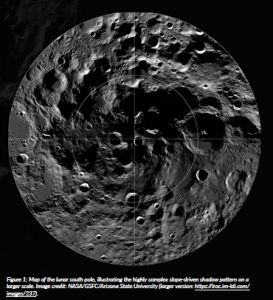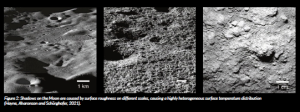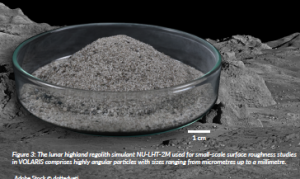- Reiss, M. Amorós-Trepat, J. N. Brecher and A. Peschel
Finding and characterising water on the Moon is among the top priorities of current space exploration endeavours.
Water plays an essential role in the history and evolution of the solar system. It also represents an essential resource for future space exploration missions. Evidence for the existence of water on the Moon has been delivered in recent decades through orbital measurements by various missions (Reiss, 2024). Several hypotheses have evolved to explain the formation and distribution of water in the lunar environment and the processes driving the water cycle. The biggest challenge is that, so far, no actual ground truth exists. Therefore, finding and characterising water on the Moon is among the top priorities of current space exploration endeavours.
Theoretical models currently provide the best insight into the dynamics of the associated volatile species. The main source, sink, and loss mechanisms involved in the water cycle are solar wind proton implantation, (micro-) meteoroid impacts, internal outgassing, cold trapping, melt trapping, conversion, burial, impact vaporisation, thermal desorption, photolysis, sputtering and thermal escape. These processes are typically modelled individually on their respective spatial and temporal scales. A model that combines these processes would allow a much more comprehensive investigation of the volatile cycle and the interdependencies of the involved parameters, and enable the prediction of water distribution and variability.
To date, the common approach to assessing the stability of water at the lunar surface is to use a fixed temperature threshold, below which the sublimation rate in a lunar environment is too low to be practically relevant. Using surface temperature maps from remote observations, this approach reveals a limited number of areas where water can potentially exist over geological timescales, mainly in extremely cold, permanently shadowed regions found in the polar regions. Recent research has indicated that including shadowing effects on a smaller scale can reveal a significantly larger number of smaller regions with potential water stability, known as micro cold traps. With the ERC Starting Grant project VOLARIS, we expand on these recent findings by incorporating new aspects, such as diurnal temperature variations and the variability of source, sink, and loss mechanisms that drive the migration of volatiles. We combine experimental simulations and numerical modelling to investigate the migration of water above and below the lunar surface, discovering new relationships for the distribution of water.
Methodology
The heart of the laboratory setup is a cryogenic thermal vacuum chamber designed to replicate lunar conditions. Inside, a sample bed is exposed to simulated lunar day-night temperature variations, ranging from approximately 100 to 400 K, in a high vacuum. The sample contains lunar regolith analogues mixed with water ice in different forms and concentrations. Temperature and water concentration are key parameters for understanding the release, deposition and migration processes of the water cycle. These are monitored continuously during the experiments, allowing the investigation of phenomena connected to subsurface volatile migration, the influence of surface topography (e.g. simulated rocks and craters), and local source mechanisms such as impact vaporisation by micrometeoroids replicated using a laser.
On the modelling side, a focus lies on effects that have an influence up to but not limited to the centimetre scale, corresponding to the physical dimensions of the laboratory experiments. On the one hand, these simulations will deepen our understanding of volatile behaviour under controlled conditions and provide a framework for validating and refining the experimental results. On the other hand, the validated models will be expanded to larger scales to predict processes in a lunar environment. A crucial step and a key challenge in enabling such broader simulations is introducing simplifications of the physical descriptions without compromising accuracy.
To address this topic, we use slope statistics derived from the Lunar Reconnaissance Orbiter’s Lunar Orbiter Laser Altimeter LOLA (Peschel et al., 2025). Extreme local slopes approach 80°, producing complex shadowing patterns as illustrated in Figure 1.
Craters, rims and boulder fields carve out a fractal patchwork of light and dark that evolves over the lunar day. It was shown that even millimetre-scale slopes create sharp enough shadows to cause significant temperature contrasts (Prem et al., 2018). Illumination is not the only variable controlled by geometry. The angle at which particles leave, bounce or migrate into the surface also changes with slope. A molecule sputtered from a steep wall may skim only tens of metres before resorbing, causing a more local mixing of volatiles as a subset of the global cycle. Capturing these angular distributions in the model is essential for coupling exospheric transport to the surface interactions. The joint experimental-computational investigation in VOLARIS will therefore enable new insights into the influence of variable topography on water migration.
Case study
Surface roughness
One of the topics addressed in VOLARIS is the study of surface roughness. Due to the lack of an atmosphere and the extremely low thermal conductivity of the lunar soil, shadows cause very high thermal gradients on the surface. As the stability of surface volatiles is highly temperature-dependent, thermal gradients lead to a complex mix of release and deposition processes, as well as chemical transformation of species, on a small spatial scale. Shadowing is thought to play a crucial role in the overall migration of water molecules across the surface, and therefore, it is essential to understand and accurately model the variation and extent of surface roughness on various scales. Currently available datasets are limited to pixel sizes of hundreds of metres for orbital measurements and tens to hundreds of micrometres for laboratory analyses of single particles, leaving a wide knowledge gap (Figures 2 and 3). We aim to close this gap by combining experimental data and simulations, global remote sensing datasets and planetary exosphere models.
Conclusion
A better understanding of the lunar water cycle has manifold implications on various levels. Insights into the global migration of water will enable more accurate predictions of instrument measurements from orbit and on the surface, thereby maximising the science return and informing future mission developments and operational planning. Investigating the impact of anthropogenic contamination sources will support efforts to preserve the natural volatile environment in the context of planetary protection and the sustainability of future lunar surface activities. The knowledge gained regarding the nature of water accumulation processes will support the assessment of resource potential and the identification of potential scenarios for resource utilisation. Future exploration missions will strongly depend on these aspects and therefore benefit from the research performed in VOLARIS.
References
Hayne, P.O., Aharonson, O. and Schörghofer, N. (2021) ‘Micro cold traps on the Moon’, Nature Astronomy 5, pp. 169–175. doi: 10.1038/s41550-020-1198-9.
Peschel, A., Grava, C., Breternitz, J. and Reiss, P. (2025) ‘Probabilistic modelling of lunar topography for improved exosphere simulations’, Europlanet Science Conference, Helsinki, Finland, 7–12 September 2025. doi: 10.5194/epsc-dps2025-451
Prem, P., Goldstein, D.B., Varghese, P.L. and Trafton, L.M. (2018) ‘The influence of surface roughness on volatile transport on the Moon’, Icarus, 299, pp. 31–45. doi: 10.1016/j.icarus.2017.07.010.
Reiss, P. (2024) ‘Exploring the lunar water cycle’, Proceedings of the National Academy of Sciences, 121(52), e2321065121. doi: 10.1073/pnas.2321065121.
Project summary
VOLARIS aims to significantly advance our understanding of the lunar water cycle. By employing numerical modelling and experimental simulation, the combined physical, chemical and thermal processes that determine the dynamic behaviour of volatile water on the Moon are investigated. This will provide new insights into how water is distributed and inform future lunar missions.
Project lead profile
Philipp Reiss is Professor of Lunar and Planetary Exploration at the Technical University of Munich. His research focuses on the exploration of water on the Moon and the processing of space resources.
Project contacts
Prof. Dr Philipp Reiss
Technical University of Munich Lise-Meitner-Str. 9
85521 Ottobrunn
Email: p.reiss@tum.de
Funding
This project has been funded by The European Research Council (ERC) under the European Union’s Horizon Europe research and innovation programme – grant agreement number 101164002.
Views and opinions expressed are however those of the author(s) only and do not necessarily reflect those of the European Union or the ERC. Neither the European Union nor the granting authorities can be held responsible for them.
Figure legends
Figure 1: Map of the lunar south pole, illustrating the highly complex slope-driven shadow pattern on a larger scale. Image credit: NASA/GSFC/Arizona State University (larger version: https://lroc.im-ldi.com/images/237).
Figure 2: Shadows on the Moon are caused by surface roughness on different scales, causing a highly heterogeneous surface temperature distribution (Hayne, Aharonson and Schörghofer, 2021).
Figure 3: The lunar highland regolith simulant NU-LHT-2M used for small-scale surface roughness studies in VOLARIS comprises highly angular particles with sizes ranging from micrometres up to a millimetre.




